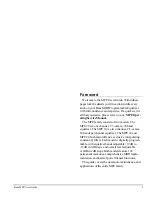
23
Since Dolby and DTS sources are detected and decoded automatically, the
default setting typically tells the unit how to process a 2-channel stereo signal.
For example, you might have your CD input default to 2-channel stereo, DVD
and game console inputs default to Dolby processing for surround material,
and TUNER input default to 5 Channel Stereo mode.
In some cases, the default setting can be manually overridden by the SUR+
button on the remote control or front panel, or 2CH, PLCM, BYPASS buttons
on the remote control. See the Manually Selecting Surround Modes section
of this manual for more information on which settings can be overridden.
AUDIO DELAY:
Also known as “lip-sync” delay, this setting delays the audio
signal for an input by the specified amount to match the video input. This
feature can be useful when the video signal is delayed more than the
audio signal.
The range of available settings is from 0 ms to 500 ms, in 10 ms steps. The
setting is individually stored for each input and is the default Audio Delay
each time that input is selected.
LEVEL ADJUST:
Use this feature to set the volume level lower than the other
inputs. This feature is useful for sources that are consistently higher in volume
than other sources in the system.
Valid settings include: 0 - -6 dB, in 0.5 dB steps.
FIXED VOLUME:
Configures a Fixed Volume level for a specified input. To
enable this feature, select the desired fixed volume level for USB, PC-USB, or
Bluetooth. When enabled and the input with a Fixed Volume is selected, the
Volume level will immediately be set to the specified level. Variable(disabled)
is factory default.
Valid settings include: Variable, 1-96.
NOTE:
The Volume knob on the front panel and /- buttons
on the IR remote are disabled when the volume is Fixed. To disable this
feature set the Fixed Volume level to “Variable”.
Press the SETUP button on the remote control or MENU button on the front
panel to exit the menu and return to normal operation.
Multi Input Setup
SOURCE : MULTI INPUT
NAME : M-INPUT
VIDEO INPUT : HDMI1
TRIGGER OUTPUT : 1 _ _
LEVEL ADJUST : 0dB
BACK
INPUT SETUP
When the MULTI INPUT source is selected on the INPUT SETUP menu, the
available options change to reflect the fact that these inputs are direct analog
inputs and bypass the unit’s digital processing. The AUDIO INPUT, DEFAULT
MODE and AUDIO DELAY options are not available since these functions
are processed digitally and not available to the MULTI INPUT source.
Configuring Audio
Audio Configuration
FRONT : Front
CENTER : Center
SURROUND : Surround
SUBWOOFER : Subwoofer
CENTER BACK : Center Back
HEIGHT 1 : Ceiling Front
HEIGHT 2 : Ceiling Rear
BACK
AMPLIFIER SETUP
: 7.1.4
AUDIO CONFIGURATION
The AUDIO CONFIGURATION menu configures the amplifier and preamplifier
RCA outputs. The screen provides options from 5.1 to 7.1.4 and an option
for 5.1 with Bi-Amplification. After selecting the desired configuration the
speaker outputs and preamplifier RCA output audio signals connections
are displayed for up to 12 channels.
NOTE:
Some outputs are only available via the preamplifier RCA
outputs and require an external amplifier.
Configuring Speakers and Audio
This section of the setup process covers items concerning audio reproduction
such as the number of speakers, bass management including subwoofer
crossovers, establishing equal output levels for all channels, delay settings,
and parametric EQ.
Understanding Speaker Configuration
Home theater systems vary in the number of speakers and the bass capabilities
of those speakers. This processor offers surround modes tailored to systems
with various numbers of speakers and bass management features which send
bass information to the speaker(s) best able to handle it – subwoofers and/
or large speakers. For optimum performance, you must tell the processor
the number of speakers in your system and how bass should be distributed
among them.
The following configuration instructions refer to LARGE and SMALL speakers,
referring more to their desired bass configuration than their physical size.
Specifically, use the LARGE setting for speakers that you want to play deep
bass signals. Use the SMALL designation for speakers that would benefit
from having their bass sent to more capable speakers. The bass management
system redirects bass information away from all SMALL speakers and sends
it to the LARGE speakers and/or the SUBWOOFER. It may be useful to think
of LARGE as “full-range” and SMALL as “high-pass filtered.”
•
Five LARGE speakers and subwoofer:
This system requires no bass
redirection. All five speakers play the normal bass recorded in their
respective channels. The subwoofer plays the normal channel bass.
Meanwhile the normal bass places higher demands on the capabilities
of the other speakers and the amplifiers driving them.
•
LARGE front, center, surround speakers, no subwoofer:
The normal
bass from the front, center, and surround channels is played in its
respective speakers.
•
All SMALL speakers and subwoofer:
The normal bass from all channels
is redirected to the subwoofer. The subwoofer handles ALL of the bass
in the system. This configuration provides several benefits: deep bass
















































